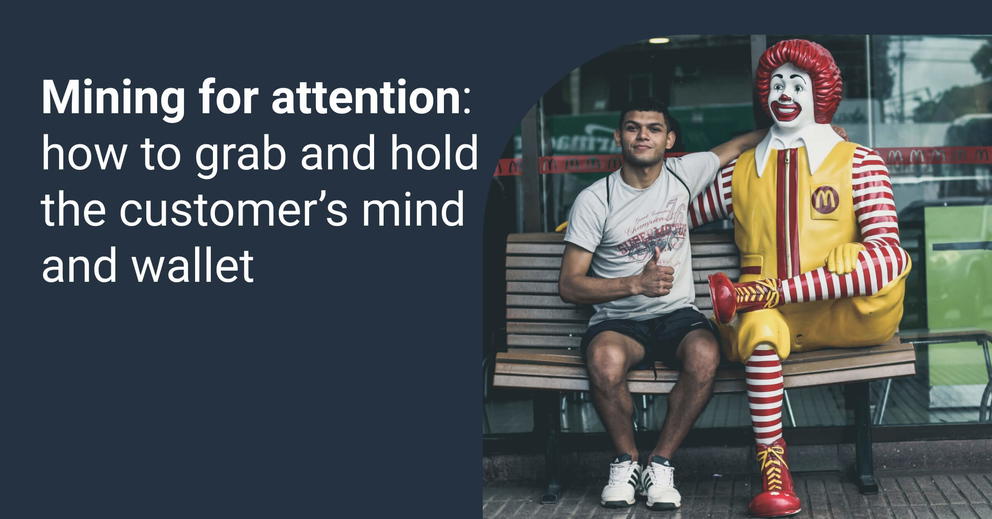Mining for attention: how to grab and hold the customer’s mind and wallet
There’s a new currency circulating around the world of marketing. No, it’s not crypto and not NFTs. We’re talking about customer’s attention. People are browsing many different platforms, and their attention span is becoming increasingly scarce. And if the attention is the new currency, marketers should invest in it and hold it, preferably to the moon.

May 28 2021 ● 6 min read

How a marketer can mine the currency of attention
There are two main ways to grab customers’ attention. Marketers can either purchase or earn it. Both of these methods could have their challenges and benefits.
- Purchased attention will spread throughout all of the channels marketers choose. It can go as far as social media platforms or TV advertisements depending on what audience the brand is focused on reaching. It will require a dedicated budget and a clear spending strategy, with reasonable KPIs and constant monitoring.
- Earning attention is a radically different approach to gaining customer attention. It’s the organic, content-based growth and slow build-up of customer trust. Using this approach can involve influencers, blogs, review sites, and other platforms that hold your customers’ attention so that you can piggyback on their authority and customer trust. Additionally, a survey done by Nielsen suggests that 83% of consumers trust friends and family recommendations. Word-of-mouth can still be the most effective way to grow brand awareness, which significantly helps with customer attention.
Ways to hold customer’s attention
Just to scratch the surface of a customer's interest is not enough to run a successful marketing campaign. Grabbing attention in the lead while holding it can be considered a conversion. And to maintain this lead, you as the marketer can employ specific strategies, such as these:
- Focus on customer satisfaction. While an effective marketing campaign may grow brand awareness, benefits could quickly fade without any sign of conversion. The first thing towards holding the customer’s attention is making their purchase journey simple, pleasant, and satisfactory. InfoQuest survey found that a delighted customer will contribute 2.6 times more revenue than a “somewhat satisfied customer”, and retaining the existing satisfied customer is 6-7 times cheaper than attracting a new one.
- Demonstrate the contrast between your product and competitors (respectfully). Transition to another product or service could be the thing your customer is searching for. In his book “Neuromarketing”, Patrick Renvoise explained that “the old brain is wired to pay attention to disruptions or changes”, such as before/after, with/without and fast/slow. To get & hold the attention, create a contrast proving your product’s best features and advantages. For example, Whatagraph has a dedicated landing page to showcase the contrast between them and their competitors - Supermetrics.
- Keep things simple. Any campaign that a marketer is releasing into the world should be simple. Complexity, especially in media platforms, tends to switch off customers’ interest. The customer is searching for simplicity and a product that is serving the purpose. Simplistic campaigns can also lead to a quick decision. It is a game-changer in today’s competitive environment. The study found that 38% of the consumers will pay more for the less complicated experience.
The practice of personalized marketing
One of the ways to hold that precious customer attention is through personalized experiences. Personalized marketing is currently on the rise: according to an Epsilon survey of 1,000 consumers (aged 18-64), 80% of them are more likely to purchase a product from a company if it offers a personalized experience. And more than 90% claim they find personalization appealing. Personalized marketing will open a huge opportunity to engage with customers and encourage them to stay with your brand in the long run.
There are endless possibilities on how far personalized marketing could go. For example:
- Personalized emails & newsletters. Including customer’s name or suggesting them to shop brand products selected per their preferences.
- Recommending other blog posts and articles based on their previous reading history. The reader can find more valuable information through recommendations and will be interested in hearing more from the business.
- Targeted discounts and offers are sparking customer’s interest more than anything. 62% of the consumers expect to receive tailored offers and discounts based on their previous purchases.
Benefits of personalized marketing
As mentioned earlier, creating a connection with your customers through marketing personalization will also create an exceptional customer experience. As shown in the Epsilon survey, customers react positively to personalized shopping experiences. This is vital in them deciding to purchase your product or service. This includes everything - from marketing messages to the checkout.
It will also increase revenue by adding more sales and conversions. Analysis by Forbes shows that marketers delivering personalized experiences to the customers get significantly more returns in performance and response.
Grabbing and holding attention is about customer retention. And by Adobe’s Digital Index, 40% of the eCommerce revenue is generated by just 8% of returning customers. The personalized marketing strategy will dramatically increase the percentage of retention.
Critical mistakes brands make while mining for attention
Mistakes made by the wrong marketing approach force customers to opt-out and search for what better suits their needs. Here are a few crucial mistakes brands can make while trying to hold customer attention:
- Wrong place, wrong time, wrong message. Impressing the customer with some sort of “wow” factor could be a good tool in the marketing strategy. However, timing is also critical. For example, right at the peak of Coronavirus back in February 2020, Corona USA released new “Corona Hard Seltzer” beer. Unfortunately, this did not impress consumers, resulting in Corona USA stock dropping, and shortly after, the new product was canceled. A different approach to impression marketing should be used.
- Poor understanding of the community. While earlier we were talking about personalized marketing, not all marketers understand their brand community. Before running a campaign of any kind, take a look at the community of your customers so your message could be on-point. For example, back in 2017, a snack company Ruffles published a post on their social media featuring the following text: “There’s a reason tofu-urkeys are never pardoned”. This implies that turkey flavor potato chips will never be changed to tofu flavor ones as a part of their “Limited Time Never” marketing strategy.
Little did the brand know that Ruffles had quite a big vegan community, and they found the communication piece extremely offensive. Shortly after, the hashtag #BoycottRuffles picked up steam, resulting in stock drops of their parent company PepsiCo. The brand’s social media profiles follower numbers fell, and even PETA expressed their criticism. In a few hours, posts from their social media were removed, and Ruffles released an apology note to all of its community. - Over-exposed marketing - or spam - is an aggressive marketing tactic aimed at reaching the consumer by any means necessary. For example, social and copy trading company eToro started using aggressive marketing back in October 2015. Launched on all social media platforms, including insanely frequent YouTube ads, eToro managed to generate an information overload that inevitably brought negative emotions and associations with the brand. Users complained about eToro’s aggressive marketing broadly: Facebook, Reddit, and Twitter.
Conclusion
So, there’s data mining, crypto mining, and now-attention mining. Some require powerful electronic tools that create even more problems and shortages in the market. Attention mining has risks of its own: it can lead to over-aggressive marketing, a drop in sales if done poorly, and so on. But with a little bit of planning and a personal touch, it seems to be still possible to retain our customers and hold their attention. To the moon.
Published on May 28 2021

WRITTEN BY
Benediktas KazlauskasBenediktas is a detail-oriented writer with a passion for marketing and technology. Using his vast experience in Business Management and Sales, he approaches every blog with the same idea: How to make readers come back for more?